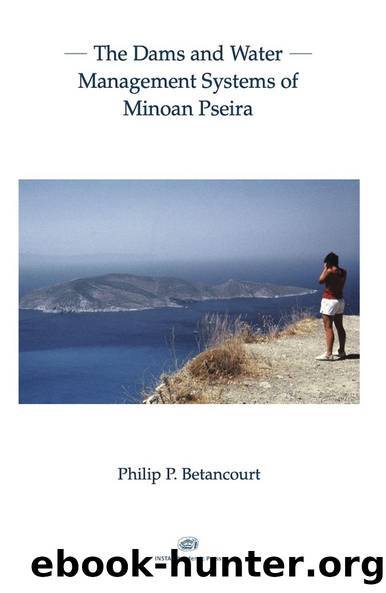The Dams and Water Management Systems of Minoan Pseira by Philip P. Betancourt Floyd B. McCoy

Author:Philip P. Betancourt, Floyd B. McCoy [Philip P. Betancourt, Floyd B. McCoy]
Language: eng
Format: epub
Tags: Social Science, Archaeology, History, Ancient, Greece
ISBN: 9781623030025
Google: P6FGEAAAQBAJ
Publisher: INSTAP Academic Press (Institute for Aegean Prehistory)
Published: 2012-11-09T05:21:27+00:00
Figure 33. Section for Terrace Q21 (after Hope Simpson and Betancourt 2005, 238, ill. 41).
Discussion
The evidence from pollen studies suggests that the climate of Crete was becoming increasingly drier during the second millennium B.C. The offshore island of Pseira would have been severely affected by this change, and it would have presented a challenge that needed a solution. The Pseirans were actively engaged in farming and small-scale animal husbandry, both of which require sufficient water for their successful continuation. Many of the plants that were raised on Pseira, like olives and grapes, do not need abundant moisture for their complete growth cycle, but they do benefit from water at planting time and when the crops are young. Sheep and goats, the main animals kept on Pseira, especially need water in the spring when the young are born and milk is needed. The two water conservation systems and the improvement of the agricultural terraces were designed to address this serious situation.
The later historical situation on Pseira helps confirm the need for an artificial water management plan to add to what would have been available naturally after the climate began changing toward the modern pattern. The island was abandoned during the Classical and Roman periods, and the absence of permanent settlements at this time helps confirm that the land was not considered very suitable for farming. When Christian monks settled on the islet during the Byzantine period, cisterns were built both at their monastery and high up in the interior of the island (Betancourt 2005, 300). The cistern at the monastery was an elaborate reservoir designed to collect rainwater from the buildingâs tile roof. It was partly underground and partly above the surface, with the space covered by a barrel vault constructed of stone and concrete. The cisterns near the Byzantine fields were carved into the bedrock. In the Venetian or Ottoman period, a concrete water tank was constructed in Dune Creek just downhill from the Minoan dam. These constructions help confirm that successful agriculture and animal husbandry on Pseira required serious water conservation after the climate changed to conditions that were drier than what the pollen analyses document for the third millennium B.C.
Both the water management systems in the two ravines and the terraces spread across the farmland used stone masonry techniques that are well known from examples in the town. They suggest that from wherever the concepts came, the physical work was grounded in local technology. Most house walls on Pseira were built from stones that were bonded together with mud mortar. A wall was often laid as a double row of stones. The blocks were placed with a flat side at the exterior and a pointed end oriented toward the interior of the wall. The mud mortar was placed at the interior so that the pointed ends of the stones were enclosed by it. The resulting wall was not affected much by rain because its exterior face was mostly stone. The mud in the interior made the wall solid
Download
This site does not store any files on its server. We only index and link to content provided by other sites. Please contact the content providers to delete copyright contents if any and email us, we'll remove relevant links or contents immediately.
Zero to IPO: Over $1 Trillion of Actionable Advice from the World's Most Successful Entrepreneurs by Frederic Kerrest(4295)
Machine Learning at Scale with H2O by Gregory Keys | David Whiting(4182)
Never by Ken Follett(3791)
Harry Potter and the Goblet Of Fire by J.K. Rowling(3774)
Ogilvy on Advertising by David Ogilvy(3510)
Shadow of Night by Deborah Harkness(3303)
The Man Who Died Twice by Richard Osman(2997)
Book of Life by Deborah Harkness(2867)
The Tipping Point by Malcolm Gladwell(2827)
Will by Will Smith(2793)
0041152001443424520 .pdf by Unknown(2784)
My Brilliant Friend by Elena Ferrante(2774)
How Proust Can Change Your Life by Alain De Botton(2742)
Purple Hibiscus by Chimamanda Ngozi Adichie(2652)
How to Pay Zero Taxes, 2018 by Jeff A. Schnepper(2602)
Hooked: A Dark, Contemporary Romance (Never After Series) by Emily McIntire(2500)
Rationality by Steven Pinker(2291)
Borders by unknow(2229)
Can't Hurt Me: Master Your Mind and Defy the Odds - Clean Edition by David Goggins(2227)
